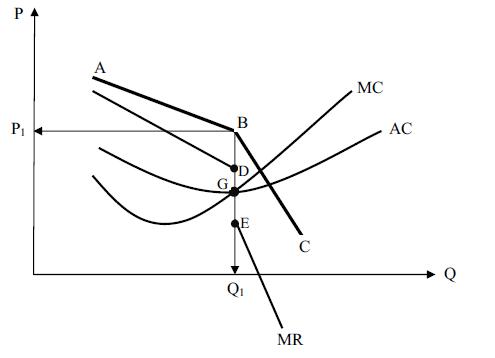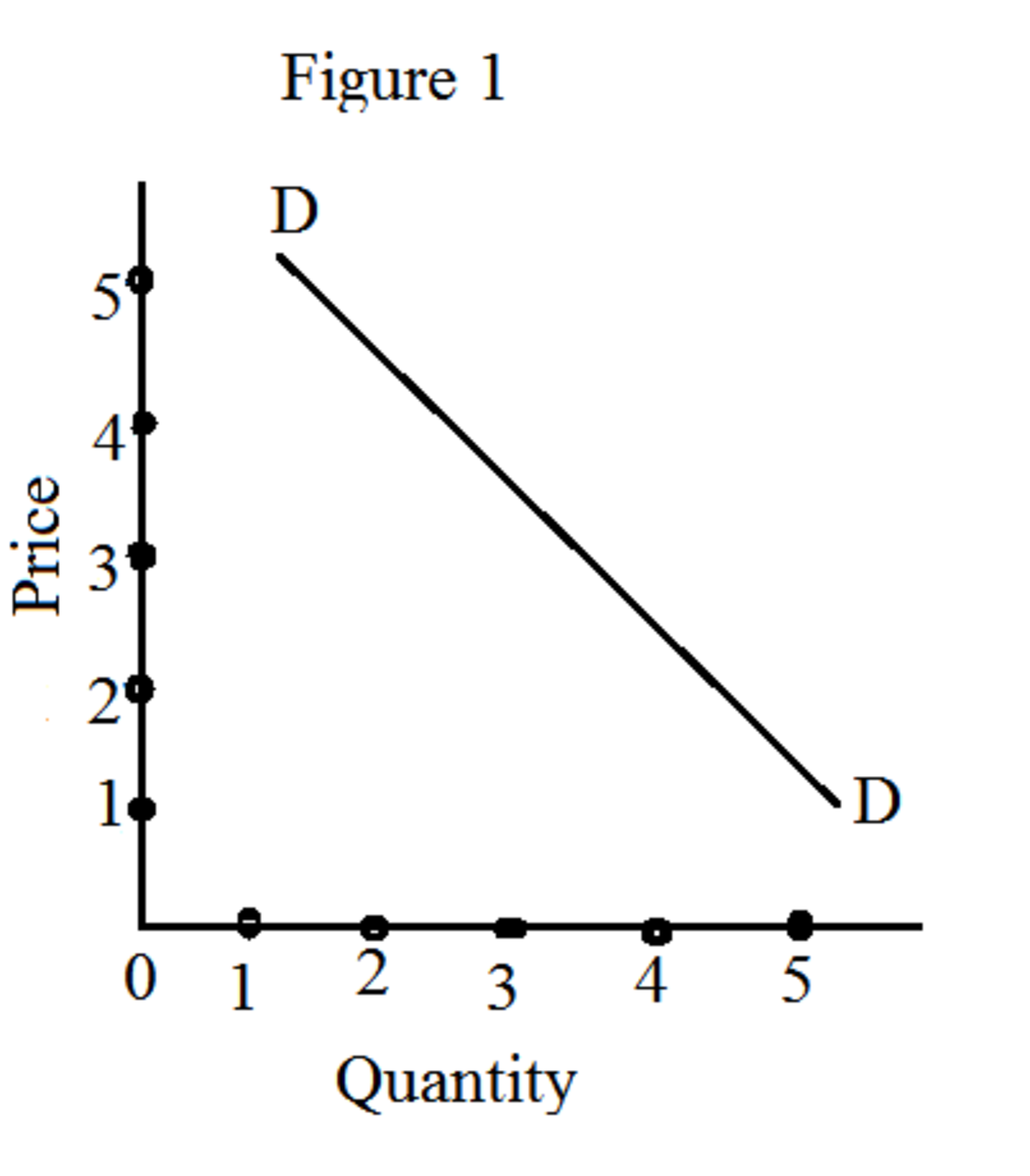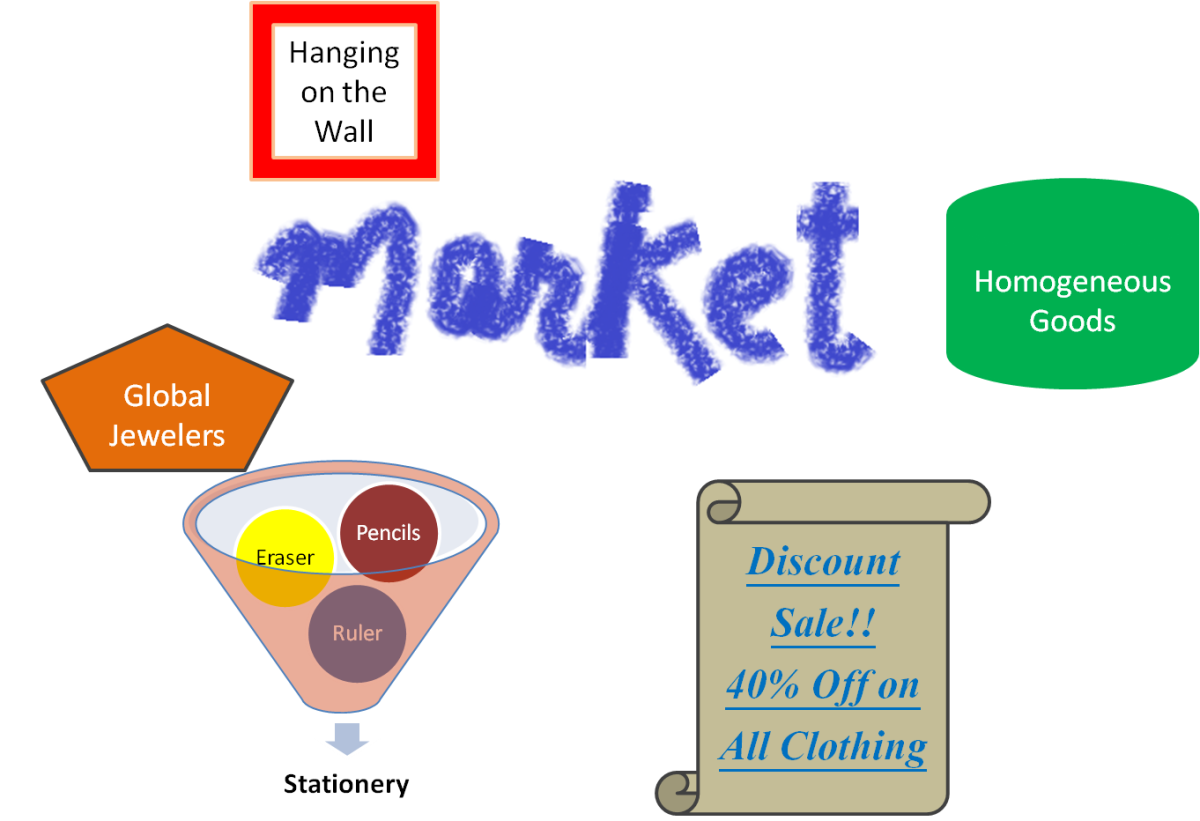Economics - Oligopoly
Long Run Equilibrium Position
Long Run Equilibrium Position
1. Equilibrium occurs at point G where (a) MC = MR & (b) MC is rising.2. The firm will produce Q1 and sell this output at price P13. The firm’s cost of production is shown at point G.4. Should costs rise between points D and E then market price tends to remain constant at P1.
5. This firm is earning SNPs because AR exceeds AC orbarriers to entry exist.
Kinked Demand Curve
Demand curve - AB If this firm increases its price others will leave their prices unchanged so this firm will lose many customers – this portion of the D/C is elastic.Demand curve – BCIf this firm lowers its price others will match this price decrease so this firm will gain few additional customers – this portion of the D/C is inelastic.
Long Run Equilibrium Position

Notes
Characteristics
1. Few Sellers in the industry.Because of this each seller can influence the price of the commodity/or the output sold.
2. Interdependence between firms.Firms in oligopoly do not act independently of each other. They will each take into the account the likely reactions of their competitors. Henceprices tend to be rigid.
3. Product Differentiation occurs.The commodities which firms sell are close substitutes. Firms will engage in advertising to persuade consumers to buy their product rather than a competitor’s product.
4. Barriers to entry.These are common in an oligopolistic market as existing firms will wish to maintain their share of the market. Examples of barriers include: high costs of setting up in the industry, brand proliferation etc.
5. Collusion may occur.Firms within the industry may meet to control the output in the industry and/or control prices e.g. OPEC
6. Non-price competition is more common than price competition.Due to the fear of how their competitors will react firms tend not to engage in price competition but rather they engage in non-price competitive measures to gain consumers.
7. Pursuing objectives other than profit maximisation. Firms may have objectives other than maximizing their profits i.e. increasing their share of the total market, limiting profits to discourage government investigation, satisfaction with the existing level of profits (e.g. in a small family business)
Price Rigidity
This occurs when prices tend not to change when costs change in an oligopolist Industry. This is because firms are fearful of the likely reaction of their competitors should they change prices.
Baumol Model
1. Prevent government market intervention/interferenceFirms may fear that the existence of supernormal profits would attract government intervention into the market and thereby restrict the firm’s activities.
2. Discourage the entry of new firms into the industryFirms may set prices at a low level which is intended to discourage the entry of new firms into the industry (limit pricing). By pursuing this policy they are forsaking higher present profits for potentially higher future profits.
3. Maximisation of sales / increased share of marketOnce a minimum level of profit is earned to reward shareholders, provide funds for reinvestment etc. the firm may concentrate on maximising sales; increasing its share of the market. It may wish to achieve economies of scale; decrease the level of sales of rival firms; become the most dominant firm in the market.
4. Maintain adequate profits.The owners of the business may prefer to earn stable/moderate levels of profits rather thanconstantly striving for large supernormal profits as this is what they are satisfied with. Where the managers are not owners they may tend towards a more conservative approach rather than a dynamic drive to profit maximisation.
Collusion
1. Pricing Policy / Limit PricingOne firm, with the tacit agreement of others, could reduce prices forcing unwanted entrants out of the industry.
2. Production/output policyFirms could join together to limit output to certain agreed amounts.
3. Sales Territories.Firms could divide up the markets between them and agree not to compete in each other’s market segments.
4. Refusal to supply firms.Firms may not supply those firms who buy from firms not in the cartel.
5. Implicit CollusionEach firm recognises that behaving as if they were branches of a single firm their joint profits would be higher. So firms do not provoke their rivals by cutting prices. Instead they try to increase market share by engaging in non-price competitive measures
Price Competition
1. Lower prices / value for moneyConsumers will benefit from availability of commodities at lower prices. Consumers will be able to get better value for their limited income.
2. Higher disposable incomeWith lower prices consumers will now have a higher disposable income, resulting in a betterstandard of living.
3. More choiceAs consumers have a greater disposable income they can now choose how to spend this additional income.
4. Preferable to non-price competitive measure because:Consumers pay for non-price competitive measures e.g. advertising;Offers may be unwanted / of little value; tokens may go unused etc.
Non Price Competition
1. Consumer loyalty rewardedConsumers can, by shopping in selected stores, receive loyalty points which can be used as they wish.
2. Stability in pricesNon-price competition means prices will not be constantly changing and so consumers do not have to worry that they are losing out on bargains / may be better able to budget.
3. Better quality commodities / servicesFirms may improve the quality of their commodities; offer better service and/ or after sales service to consumers.
4. Allows consumers to save and / or avail of ‘free’ giftsWith regular shopping consumers can ‘save’ their loyalty points for those time periods when they incur additional expenses e.g. Christmas; Easter etc. Consumers may benefit from ‘free’ gifts from retailers e.g. free turkeys at Christmas.
5. More informed consumersThrough advertising consumers may acquire more information about products and services and so can make more informed choices.








